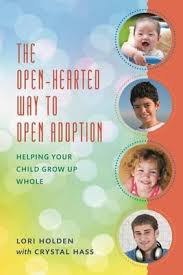 It’s hard to take issue with a book that calls itself The Open-Hearted Way to Open Adoption — harder still when that book lives up its billing in such an open and honest way that this one does.
It’s hard to take issue with a book that calls itself The Open-Hearted Way to Open Adoption — harder still when that book lives up its billing in such an open and honest way that this one does.
The Open-Hearted Way To Open Adoption by Lori Holden with Crystal Hass is a big, generous, and yes, open-hearted, book — the guide that the open adoption community has been waiting for. Insightful and entertaining, it not only explains why you should do an open adoption, but shows you how to do it with grace and confidence.
There’s so much to like about this gift of a book that it’s hard to know where to begin. So let’s start at the beginning. The way Lori sees it, adoption creates a split in a person’s biology and biography. Openness is a way to heal that split and help the child become whole.
Most people think of open adoption as a process where birthparents and adoptive parents exchange identifying information about each other and maintain an ongoing relationship through photos or visits or whatever. But for Lori, open adoption is much more than that. Rather than see it simply as an arrangement or a contract between two parties, “openness is the spirit in which we parent, teach, counsel, and listen to our children.”
Open adoption scares prospective adoptive and expectant parents
Mention open adoption to prospective adoptive parents or expectant parents and their first reaction is typically one of fear. In the case of the adopting parents, it’s fear of the birthparents changing their minds (before the placement) and coming back to reclaim their child (afterwards). In the case of the birthparents, it’s the fear that the adoptive parents aren’t everything they say they are (before the placement) and that the adoption will be closed down (afterwards).
To the uninitiated, entering into an open adoption must seem like a crazy, even reckless, idea. As Lori writes, “as a birth parent, why would you want to stay in the life of child you placed? Why subject yourself to the feelings that might emerge when you hear your child call another woman Mama or another man Daddy? As an adoptive parent, why would you complicate your life by having birth parent around — people who have a seeming competing claim on your child.”
Why indeed? And yet for Lori, the answer is simple. You do it for your child, who is at the center of your relationship. Once you look at things through a child’s eyes, everything suddenly changes. Far from being adversaries, birthparents and adoptive parents become allies, united in their desire to act in the best interests of their child.
And that — moving from fear to family — is the starting and ending point of The Open-Hearted Way to Open Adoption. “More than a how-to, this book shares a mind-set, a heart-set, that can be learned and internalized. This mind-set/heart-set becomes an inner-navigation system that equips you to act confidently from love and not fear.”
Lori doesn’t just talk the talk. She also walks the walk, providing tools and real-examples to guide you through the process. As an adoptive mother of two, she knows first-hand that open adoption isn’t always smooth sailing. It’s a leap of faith, a journey into uncharted waters, one that has its own set of laws, rules and regulations. Even its own language, which is why she devotes the first part of the book to laying out her terminology. It’s as if she wants to make sure that everyone is on the same page, literally, from the get-go.
If you’re looking for the latest research on open adoption, it’s there, enhancing the book’s credibility. But by drawing on the observations and experiences of other open adoption bloggers, Lori gives her book something else: authenticity.
Features other adoptive parent and birthparent stories
One of the great strengths of The Open-Hearted Way to Open Adoption is how Lori incorporates other voices in her narrative. And I’m not just talking about other adoptive parents and birthparents whose stories are sprinkled throughout the book. Also included are observations by Crystal Hass, the birthmother of Lori’s daughter.
I loved reading Crystal’s thoughts about a host of issues ranging from the use of the term “birth mom” (she likes it) to prebirth matches (it worked for her, but she can also see how they could be used as weapons to coerce and control others). And I especially liked getting her side of the story of her relationship with Lori and her family, including her explanation about why it was important for her that Lori and her husband feel happy leading up to the placement even though their happiness was tied to her sadness.
My only complaint, if I can call it that, is that I wish there was more of Crystal. But that would have meant having less of Lori, and that would have been a shame since Lori is such an engaging and entertaining guide — a “cool ass lady,” in the words of one reviewer.
Plus, let’s not forget this is Lori’s book — although Crystal gets a writing credit. But again, it’s a minor quibble — just one more example of open adoption’s push and pull that Lori addresses so well in her narrative. Perhaps one day in the not-too-distant future, Crystal will write her own book about her open adoption experiences. With Lori, of course.
